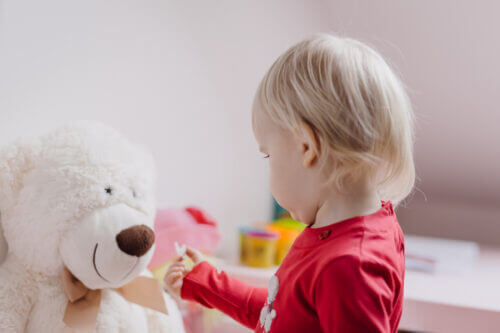Dana asks: How do babies know how to choose gender-appropriate toys, why do girls play with dolls and boys with cars?

Even in modern and feminist families it is not difficult to distinguish between a son's room and his sister's room: it is difficult to find many boys who will comb, feed and educate their doll and there are not many girls who spend their time smashing toy cars. There are those who see this difference as the seed of disaster - the beginning of directing girls to "feminine" occupations that involve taking care of people and boys to rewarding technology. We, the adults, are very sensitive to the play preferences of the children. Observations of parents and children reveal that fathers and mothers tend to reward children who play with toys that are "appropriate" for their gender, either with a word of encouragement or by participating in a game, while a son who chooses to hug the doll or a daughter who is enthusiastic about the rifle will receive, at best, demonstrative disregard.
As usual, there is no justice in the world, girls who prefer boys' games are treated more tolerantly than their parents boys who show affection for girls' toys. This imbalance is embedded in the culture: children are exposed to "tomboy" characters like Bilby and even Disney movies show them Merida, Moana and Mulan, but the shelves of children's books and children's movies are devoid of female characters. Children seem to accept the conventions: watching children who are given free access to several types of toys reveals that girls play with all types of toys and show a moderate preference for dolls and play accessories that simulate a home environment, while boys completely ignore girls' toys and devote themselves to "male" toys: vehicles, construction toys and of course War toys almost the entire game time.
A lot of research has been done to find out if the children know how to choose the toys because they internalized the message their parents gave them or if they are biologically programmed for different preferences. The task is not easy because the diagnosis between the sexes and the link between the sex and the actions or roles associated with it culturally is among the first items of information that we bother (usually unconsciously) to teach the child. Already at the age of 18 months, babies know how to match a figure of a boy or a girl with a toy identified with the same gender. There is a need, therefore, for creative ways to create a distinction between the influence of the environment and what biology has given us.
Researcher Vicki Pasterski (V. Pasterski) followed a unique group: girls suffering from CAH - congenital adrenal hyperplasia, a hereditary disease that causes an increased secretion of the male sex hormone testosterone while still in the womb. These girls are diagnosed at birth, treated with medication to balance the hormones and undergo surgery at a young age to shape genitalia to a typical female shape. The researchers allowed the girls to play with a variety of toys, some "feminine" such as a Barbie doll with a set of clothes and accessories, make-up tools and a baby doll and some "masculine" such as a toy car, a Lego airplane, a set of tools, a helicopter and a gun. Monitoring these girls, who, as mentioned, look like normal girls and are brought up that way, discovered that their parents try to reinforce stereotypical female behavior in them more than parents of "normal" girls. Fathers and mothers of girls with CAH syndrome were much more likely to praise their daughters for playing with girls' toys, the same parents also tried much more to prevent their daughters from playing boys' games Compared to other parents. These girls, despite the efforts of persuasion and seduction, showed a clear preference for boys' games. Just before we adopt the simplistic approach of "female brain loom male brain" it is worth noting that the "masculinity" of girls with CAH syndrome stops at the choice of toy, in terms of the degree of aggressiveness and competitiveness In the game they act like stereotypical girls. The study showed that the hormonal environment of the fetus has significance in determining the child's preferences but still does not answer the question: what makes a toy masculine or feminine?

Other researchers who sought to neutralize the influence of culture turned to the zoo. When rhesus monkey pups were given the choice between boys' toys (vehicles) and dolls, behavior reminiscent of human children was observed. The males clearly preferred toys with wheels, while the females played with the whole range of toys with a slight preference for dolls. In monkeys, the mothers do not intervene in the cubs' games, so the difference in preferences can definitely be attributed to innate differences between the sexes. This experiment and similar observations in vervet monkeys where the males played with all the toys but the females ignored the boys' toys and only played with the dolls proves that biology alone directs the boys to male toys and the girls to Barbies. And yet it is also possible to notice interesting differences between us and our tailed brothers. Those who attribute the entire difference between the play habits of boys and girls to Mother Nature would probably expect more "masculinity" and "femininity" in the monkeys compared to human children, but the relationship is actually the opposite. When given a free choice, the rhesus monkey pups spent about 20% of their time playing with the dolls, the human boys devoted only 8% of their time to the dolls. It seems that society tries and actually succeeds in exaggerating differences between the sexes. For example, it was found that at the age of 5 boys choose more "masculine" toys when they are aware that they are being watched and boys' reluctance to dolls decreases when they are blue and not pink. When giving 4-year-old children neutral toys (nutcracker, garlic crusher...) Boys will be more interested in them if they are painted blue and presented as boys' toys and girls will prefer the same items when they are painted pink and presented as girls' toys.
Men and wheels
Looking at the list of toys that the male monkey cubs preferred, it becomes clear that along with the toy car and the truck, there is another means of transportation: a shopping cart, a "girl's toy" in human terms. What attracted the monkeys to the boys' toys was not "masculinity" but the wheels. In this way, the monkeys show a resemblance to human babies: the study in which toddlers' reactions to toys that were assembled "incorrectly" was recorded, it became clear that boys notice a damaged car (wheels are missing or part of them is glued to the roof) as early as the age of two: more than six months before they notice that something is wrong with the doll with the hands come out of the sides of the head or switch positions with the legs. Girls notice the incompatibility of the doll with the shape of the human body before the boys and are late to notice that something is wrong with the car.
There is a difference, it turns out, between what attracts girls' attention and what boys will focus on, researcher Gerianne M. Alexander chose, therefore, to check where children who do not yet understand what the toys represent look at. It turns out that already at the age of six months, boys focus their gaze on a toy truck more than on the doll shown to them, while the girls at the same tender age prefer to look at the doll. The image projected onto the retina is the same in boys and girls but, Alexander hypothesizes, there is more than one way to analyze it. The information received by the eye is analyzed in two information processing pathways in the brain: one dealing with the identity of the object (what is it) and the other with its location in space and its movement (where is it). It seems that in us, as in other mammals, sex hormones influence the degree of development of both pathways. Girls focus more on objects in which there are more details to decipher and in particular human faces, while boys focus more on objects that can be pushed, rolled and it is necessary to check the trajectories of movement for them. Both boys and girls will prefer to focus on human faces and will prefer moving objects to stationary ones, but when given a choice, one-year-old boys will prefer to focus on a moving object (such as a mobile), while girls will prefer stationary faces.
so what?
A word of reassurance in conclusion: there is no evidence that girls who nurture dolls as children will be less feminists than their friends who love Lego. It turns out, surprisingly, that most of us are smart enough to tell the difference between childhood games and the real world. What has been found to influence the attitudes of children regarding the roles of women and men are not the toys but another element in their environment - the adults. The more equal the division of roles in the home, the less conservative the children's attitudes regarding the roles of women and men. If you want, Dana, that your daughter won't be chained to the kitchen when she grows up, don't bother with her dolls: just make sure she sees daddy washing real dishes in the kitchen.
thanks to:
Dr. Michelle Heron, Dr. Vickie Pasterski, Dr. Gerianne Alexander, Dr. Kim Wallen, Dr. Judith Blakemore
Did an interesting, intriguing, strange, delusional or funny question occur to you? Send to ysorek@gmail.com
More of the topic in Hayadan:

6 תגובות
Is it possible to get a reference to the research done with the monkeys at the zoo,
Nice to find your column on the science site.
I also enjoyed reading it in its previous incarnation, if I'm not mistaken about 'mint'.
Great article.
Wonderful score as well
An article that will upset a lot of psychopathic progressives and crazy feminists
One of the most beautiful articles I have ever read on this site.
Thanks. It is very interesting. I was not familiar with these studies, and it is very consistent with my experience as a parent. I also wrote about it a few years ago.
https://tozeretbyte.wordpress.com/2014/12/04/כל-צבעי-הקשת/